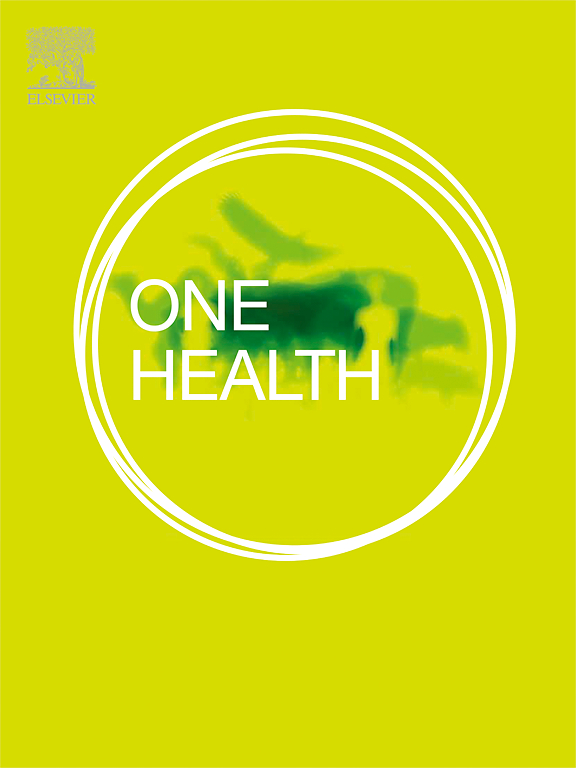Metabarcoding analysis of the microbiota in flocks naturally infected by Coxiella burnetii: First description of the global microbiota in domestic small ruminants
IF 4.1
2区 医学
Q1 INFECTIOUS DISEASES
引用次数: 0
Abstract
This study investigates Q fever in sheep and goats, key reservoirs for human infection, by metabarcoding and comparing it with q-PCR and serology. Samples from 26 small ruminants (aborted and normal-delivery) and six males across three Q fever-affected herds were analyzed. In sheep herds, seropositivity was 50 and 80 % respectively, with Coxiella (C.) burnetii shedding detected vaginally in the second herd. In goats, 100 % seropositivity and 90 % C. burnetii detection were observed, with nasal and vaginal samples showing the highest detection rates. Metabarcoding revealed significant differences in alpha diversity, with greater richness in blood and evenness in milk from normal-delivery sheep and higher evenness in faeces from aborted sheep. Beta diversity showed distinct vaginal microbiota in normal-delivery females compared to aborted ones. Firmicutes was the most abundant phylum observed. Dominant genera included: Moraxella (nasal), Mycoplasma (blood), Streptococcus (milk), Ureaplasma (vaginal and preputial), Rikenellaceae RC9 gut group (faeces). Significant differences in bacterial composition, including infertility-linked vaginal pathogens, were found across female groups in all herds in the anatomical locations studied, revealing new species and tropisms. Moreover, taxonomic analysis identified C. burnetii in vaginal, milk and environmental samples. This first report of C. burnetii in the caprine nasal cavity suggests an underestimated tropism that may improve Q fever diagnosis. These findings underscore the need for herd-wide Q fever control measures, including males and normal-delivery females. Our findings contribute to new insights into the pathogen's impact on small ruminant microbiota and a novel approach to studying infectious diseases in this sector.
自然感染伯纳氏克希菌群微生物群的元条形码分析:首次描述全球家养小反刍动物微生物群
本文采用元条形码法对人感染主要宿主羊和山羊的Q热进行分析,并与Q - pcr和血清学进行比较。分析了来自3个Q热感染畜群的26只小反刍动物(流产和正常分娩)和6只雄性的样本。在绵羊群中,血清阳性率分别为50%和80%,在第二群中检测到阴道布氏科希氏菌脱落。在山羊中,100%的血清阳性率和90%的伯纳蒂胞杆菌检出率被观察到,其中鼻腔和阴道样本的检出率最高。元条形码显示了α多样性的显著差异,正常分娩羊的血液和牛奶更丰富和均匀,而流产羊的粪便更均匀。与流产的女性相比,正常分娩女性的阴道微生物群表现出明显的多样性。厚壁菌门是最丰富的门。优势属包括:莫拉菌(鼻腔)、支原体(血液)、链球菌(乳汁)、脲原体(阴道和包膜)、利肯菌科RC9肠道群(粪便)。细菌组成的显著差异,包括与不孕相关的阴道病原体,在所有动物群的雌性群体中都被发现,揭示了新的物种和倾向。此外,分类分析还在阴道、乳汁和环境样本中鉴定出伯氏原体。这第一份报告在山羊鼻腔布氏梭菌提示一个被低估的倾向,可能提高Q热的诊断。这些发现强调需要采取全群Q热控制措施,包括雄性和正常分娩的雌性。我们的发现有助于对病原体对小反刍动物微生物群的影响有新的认识,并为研究该领域的传染病提供了新的方法。
本文章由计算机程序翻译,如有差异,请以英文原文为准。
求助全文
约1分钟内获得全文
求助全文
来源期刊

One Health
Medicine-Infectious Diseases
CiteScore
8.10
自引率
4.00%
发文量
95
审稿时长
18 weeks
期刊介绍:
One Health - a Gold Open Access journal.
The mission of One Health is to provide a platform for rapid communication of high quality scientific knowledge on inter- and intra-species pathogen transmission, bringing together leading experts in virology, bacteriology, parasitology, mycology, vectors and vector-borne diseases, tropical health, veterinary sciences, pathology, immunology, food safety, mathematical modelling, epidemiology, public health research and emergency preparedness. As a Gold Open Access journal, a fee is payable on acceptance of the paper. Please see the Guide for Authors for more information.
Submissions to the following categories are welcome:
Virology,
Bacteriology,
Parasitology,
Mycology,
Vectors and vector-borne diseases,
Co-infections and co-morbidities,
Disease spatial surveillance,
Modelling,
Tropical Health,
Discovery,
Ecosystem Health,
Public Health.
 求助内容:
求助内容: 应助结果提醒方式:
应助结果提醒方式:


